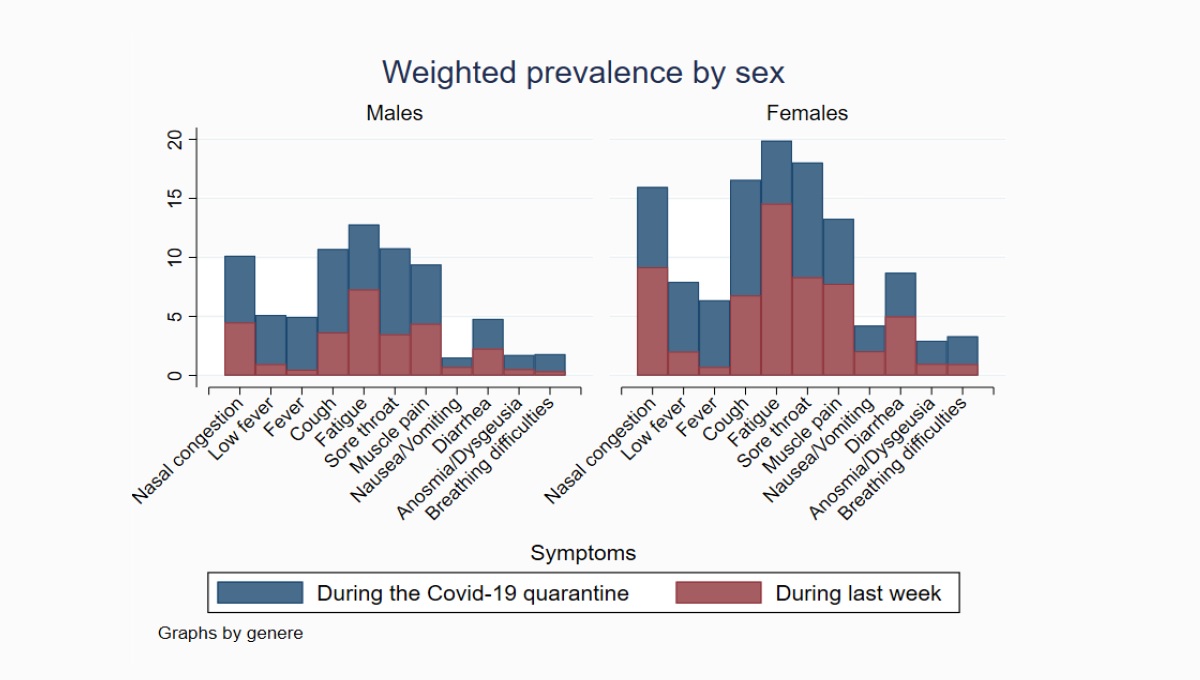COVID-19-like symptoms and their relation to SARS-CoV-2 epidemic in children and adults of the Italian birth cohort
Publication date: 15/05/2020 – E&P Code: repo.epiprev.it/1634
Authors: Maja Popovic1, Chiara Moccia1, Elena Isaevska1, Giovenale Moirano1, Costanza Pizzi1, Daniela Zugna1, Franca Rusconi2, Franco Merletti1, Milena Maule1, Lorenzo Richiardi1
Abstract: Background. Emerging COVID-19 pandemic caused extensive lockdowns in a number of countries, but yet unknown number of cases positive to SARS-CoV-2 escapes surveillance systems.
Methods. Mothers participating in the Italian NINFEA birth cohort were invited to complete an online questionnaire on COVID-19-like symptoms in the household. We estimated the population prevalence of COVID-19-like symptoms in children and adults, assessed their geographical correlation with the cumulative number of COVID-19 cases by province, analysed their clustering within families, and estimated their sensitivity, positive (PPV) and negative predictive values (NPV) for COVID-19 diagnosis in individuals tested for SARS-CoV-2.
Results. Information was collected on 3184 households, 6133 adults, and 5751 children. There was a strong geographical correlation between the population cumulative incidence of COVID-19 and the prevalence of muscle pain, fatigue, low-grade fever, and breathing difficulties in adults (Spearman’s rho ≥0.70). Having at least one family member with a COVID-19 diagnosis, compared with none tested for SARS-CoV-2, was associated with an increased prevalence ratio of almost all COVID-19-like symptoms in adults, and only of low-grade fever (37-37.5oC; prevalence ratio 5.27; 95% confidence intervals: 2.37 to 11.74) and anosmia/dysgeusia in children. Among adults with COVID-19, fatigue, muscle pain, and fever had a sensitivity ≥70%. In individuals tested for SARS-CoV-2, with a 16.6% prevalence of COVID-19, breathing difficulties and nausea/vomiting had the highest PPVs, with point estimates close to 60%, and with NPVs close to 90%. Among tested Piedmont residents, with a COVID-19 prevalence of 18.5%, breathing difficulties and anosmia/disguesia reached PPVs above 80%.
Conclusion. Geographical prevalence of COVID-19-like symptoms in adults may inform on local disease clusters, while certain symptoms in family members of confirmed COVID-19 cases could help identification of the intra-familial spread of the virus and its further propagation in the community. Low-grade fever is frequent in children with at least one household member with COVID-19 and possibly indicates child infection.
Cite as: Maja Popovic, Chiara Moccia, Elena Isaevska, et. al. (2020). COVID-19-like symptoms and their relation to SARS-CoV-2 epidemic in children and adults of the Italian birth cohort. E&P Repository https://repo.epiprev.it/1634
Topic: COVID-19
Key words: COVID-19, NINFEA, prevalenza, SARS-CoV-2, sensibilità, sintomi,
AVVERTENZA. GLI ARTICOLI PRESENTI NEL REPOSITORY NON SONO SOTTOPOSTI A PEER REVIEW.
Info
Affiliations:
1 Cancer Epidemiology Unit, Department of Medical Sciences, University of Turin, and CPO Piemonte, Turin, Italy
2 Unit of Epidemiology, Meyer Children’s University Hospital, Florence, Italy
Authors’ contributions: –
Competing interests: None
Funding disclosure: The NINFEA study was partially funded by the Compagnia San Paolo Foundation, which had no role in the design of the study, collection, analysis, or interpretation of data.
Ethics committee approval: The NINFEA study was approved by the Ethical Committee of the San Giovanni Battista Hospital and CTO/CRF/Maria Adelaide Hospital of Turin (project number 45) and all the participants gave informed consent at enrolment and after completing each study follow-up questionnaire. A specific amendment to the Ethical Committee was submitted for the COVID-19 survey.
Copyright: Il detentore del copyright è l’autore/finanziatore, che ha concesso a “E&P Repository” una licenza per rendere pubblico questo preprint. The copyright holder for this preprint is the author/funder, who has granted E&P Repository a license to display the preprint in perpetuity.
Terms of distribution: No riutilizzo/No reuse

Weighted prevalence of COVID-19-like symptoms in adults between February 21st 2020 (date of the first COVID-19 case reported in Italy) and the date of completion of the questionnaire, and in the last week before the completion of the questionnaire, by sex
References & Citations
Google Scholar

